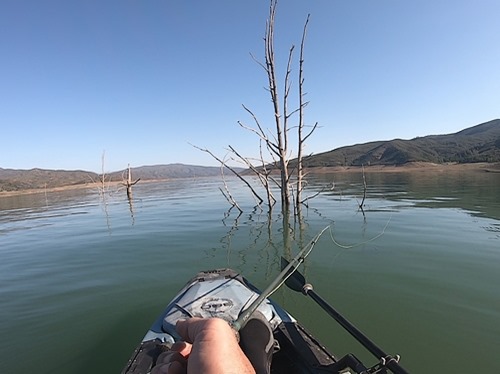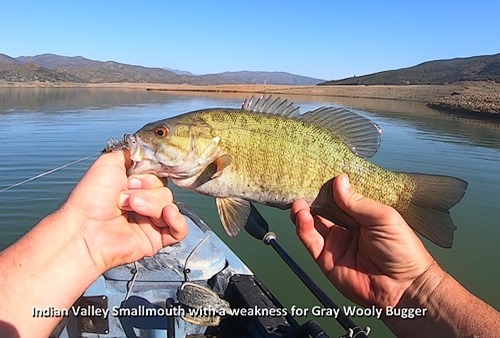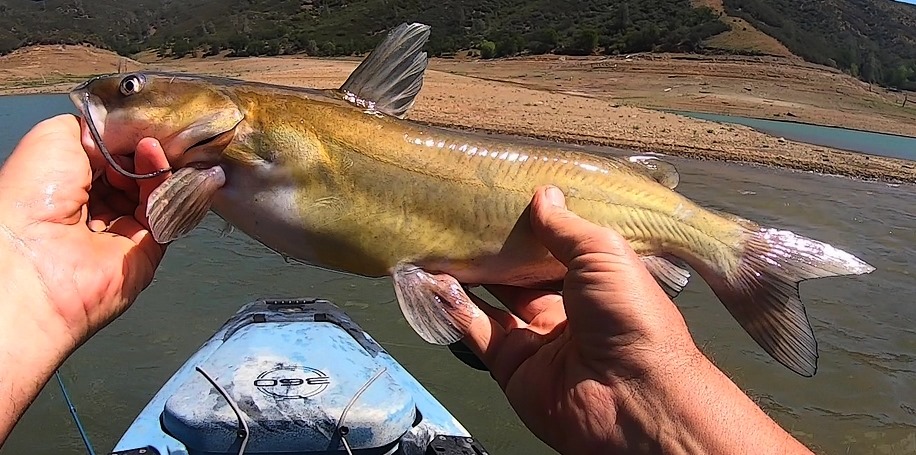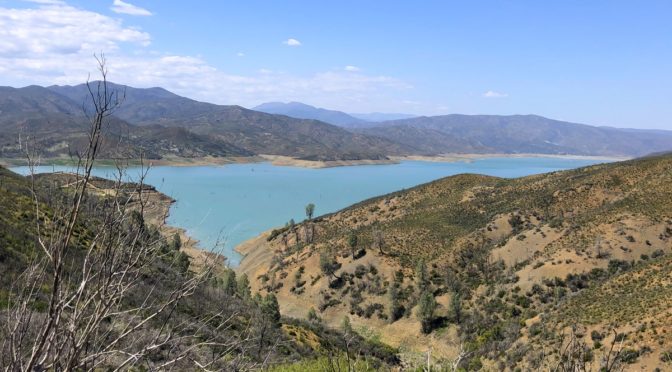Conditions: Morning temperatures about 61 degrees, afternoon about 80 degrees. Gusty mid morning winds to about 20 mph, dying in early afternoon to a steady breeze. Water temperature measured at 58 – 60 degrees.
I figured all my recent scouting and fishing “hard knocks” would eventually put me in the proper water at the right time, as it’s the nature of taking so many cuts at the ball – eventually you have to connect.
Today was Indian Valley Reservoir, which is off of HWY 20 near Clear Lake, CA. To get to the lake requires tracing the ridgeline on a 12 mile long, spine jarring and dusty, dirt road, replete with all the divots and pot holes that come from a lot of off road traffic and the hellions that practice that fine art.
Indian Valley is a BLM management area and frequently hosts off-road clubs and the California Militia, which is mix of Off-road Crazies, Trump supporters, and leavened with Proud Boys and castoff Fox News anchors, and it’s not uncommon to encounter well armed Turkey hunters on the way in – and better armed camo-clad militia on the way out.
It’s safe to assume you’re outgunned … so wave cheerily and try to minimize the rocks and dirt you spatter them with – as you blow past.
The lake proper has a small campground (without water) next to the dam, a long concrete ramp used to launch boats, and is operated by the Yolo County Water District, which is very tight-lipped about information on the locked gate and whether the lake is open or closed. The Bureau of Land Management operates the surrounding terrain, and may be the better source for early and late season access status.
I got to the lake around 9AM and was the only person at the campground. No boat inspection despite the numerous placards mentioning fines. Lake County requires Quagga inspection stickers on all boats (you must have one for the current month), but kayaks are exempt from this requirement. There is a $6 day use fee ($15 for overnight camping) that is collected via honor system.
With the lake like glass I started on the West side of the dam and fished through all the sunken timber enroute to the North end of the lake, some miles distant. In normal years the lake is about six miles long, but this year it’s only about two-thirds full, so is closer to four miles in length.

Indian Valley is full of timber and underwater stumps, and the lake has a posted speed limit of 10mph for all boat traffic due to the danger of disemboweling your craft. All that wood makes for a marvelous fishing environment, when you’re not snagging up, as there’s nothing like fishing at something – versus blind casting hoping for something to swim by.
I found the Smallmouth Bass first. They were overly protective of the rocky points entering the lake and dragging a #4 Grey Wooly Bugger over the shallow hump would often bring something from the deeper water to the sides.

I landed about a half dozen fish while wandering about the West bank, and got thumped by something that felt bigger ..

Indian Valley Catfish, my first on the fly
… which wound up being a good sized Catfish, my first on a fly rod. I had seen numerous Catfish caught on flies in magazines, but this was the first I had caught on my own. It was a great fight and a worthy adversary. The thought of fish dinner entered my mind – as Catfish are wonderful table fare, but I opted to release him instead.
Indian Valley Reservoir is plagued by wind that materializes about 11AM and lasts through till the afternoon. You anticipate this gusty period, as the initial burst is quite blustery, but typically will die back in early afternoon. I always bring conventional tackle to fish during the worst of the wind, as fly rods are ineffective and dangerous when gusts start ripping down the valley.
Emboldened by early success I pedaled over to the East side of the lake just in time to greet the blustery Northern wind that pushed me back South towards the dam. Waves appeared almost immediately and made for a few anxious moments as I adjusted for the return crossing with waves hitting broadside to the boat. Angling kayaks are a little less seaworthy than their sunken cockpit cousins, so I took a 45 degree course to give me a “following sea” and less of a tipping issue with the waves hitting me obliquely versus broadside.
Returning to the West side I shelved the fly rod and beached the kayak to make it easier to fish in high wind. I tried a mix of Spinnerbaits, top water plugs, jigs, and finally settled on tossing a 6” Green Pumpkin Senko (#318 Green Pumpkin with large Red flake) into the deeper water.
With the change in tackle (and depth), the Largemouth appeared – and couldn’t leave the Senko alone. I landed a couple dozen fish (and an even larger Catfish!) during the worst of the windy period all on the big rubber worm.
It’s a lesson I’ve learned many times over. Scouting large bodies of water requires numerous tackle types to get a firm read on quarry and conditions. Fly fishing has glaring weaknesses – casting distance and fishing at depth being the most obvious, and being able to fish through a blustery three hours with conventional gear made quite the difference in understanding where the fish were holding – and what they thought tasty.
In short, had a great trip – caught quite a few fish – and of the four lakes scouted this week, found Indian Valley bite to be “earlier” than the others, something I will log and confirm in coming years.
Indian Valley is all rock and shale covered with a leavening of goopy algae. I saw no evidence of spawning fish, no beds of any kind, no Crappie, Kokanee, or Carp, and no humans nor trash (even in the campground).
Some observations and cautions: The road to the lake does not need four wheel drive, despite the many potholes, and there is no cell phone coverage, so if you get stuck you’re on your own. Remember if you launch a boat you’ll need to get Quagga inspected (Lake County requires MONTHLY inspections) and go slow on the water as the sunken timber is quite thick in the coves and edges of the lake.
This is heavy Rattlesnake country, so if you camp or bring little people, you need to keep an eye out for visitors. There is little water in the area other than the lake – so anything resident to the area must move to the water which may mean unsolicited visitations or encounters in the brush surrounding … there are tons of snakes in the area.

